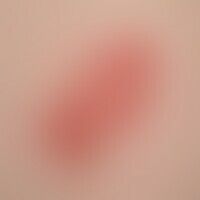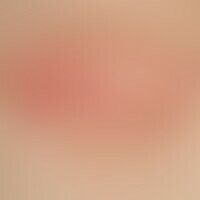Bowen's disease Images
Go to article Bowen's disease

Bowen, M.: solitary plaque, progressive in size, occasionally accompanied by itching, measuring 1 x 7 cm, sharply and arching, border-emphasized plaque, on the right lumbar side in a 74-year-old woman; a reddish, partly scaly aspect and central fading are impressive.

Bowen's disease: sharply defined plaque that has existed for 2 years, interspersed with scales, crusts and erosions. Clear actinic damage to the skin of the back of the hand (therapy: 5% Imiquimod cream, 3 x per week under occlusion, complete healing).

Bowen's disease: Sharply bordered brownish plaque that has existed for 2 years, is completely asymptomatic, sharply bordered and brown in colour.

Bowen's disease: detailed view

Bowen's disease: Chronically stationary, slowly increasing in area and thickness, sharply defined, meanwhile clearly increased in consistency, symptomless, red, rough, partly scaly, partly erosive, partly crusty plaques on the left thumb extension side of a 63-year-old man; characteristic is the occurrence mainly in the area of light-exposed skin areas.

Bowen's disease: solitary, chronically dynamic, slowly and continuously growing for 14 months, asymptomatic, sharply defined, approx. 1.5 x 1.0 cm large, scaly, rough plaque on the prepuce of a 71-year-old man

Bowen's disease:long-standing, slow-growing, sharply defined large-area, sometimes erosive, sometimes scaly, less symptomatic, sometimes slightly burning, red plaque.

Bowen's disease with transition to Bowen's carcinoma: solitary, size-progressive plaque that has been present for several years, occasionally accompanied by itching, sharply and arc-shaped, border-emphasized plaque with increasing verrucous nodular formation (see following figure).

Bowen's disease: chronically stationary, slowly increasing in area and thickness, sharply defined, now clearly (knot formation), symptom-free, red, rough, sometimes scaly and crusty plaque on the palm of the hand.

Bowen's disease with transition to Bowen's carcinoma: solitary, size-progressive plaque that has been present for several years, occasionally accompanied by itching, sharply and arc-shaped, border-emphasized plaque with increasing verrucous knot formation (white encircles the zone with the beginning invasive growth).

Differential diagnosis Bowen's disease: in this case an atypical mycobacteriosis.





